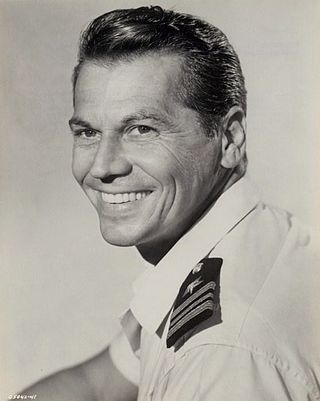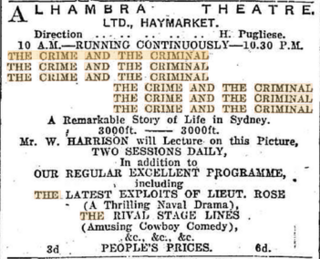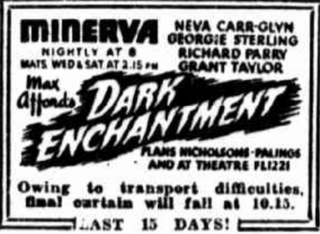Related Research Articles

Jack Thompson, AM is an Australian actor and a major figure of Australian cinema, particularly Australian New Wave. He is best known as a lead actor in several acclaimed Australian films, including such classics as The Club (1980), Sunday Too Far Away (1975), The Man from Snowy River (1982) and Petersen (1974). He won Cannes and AFI acting awards for the latter film.
Robert James Ellis was an Australian writer, journalist, filmmaker, and political commentator. He was a student at the University of Sydney at the same time as other notable Australians including Clive James, Germaine Greer, Les Murray, John Bell, Robert Hughes and Mungo McCallum. He lived in Sydney with the author and screenwriter Anne Brooksbank; they had three children.

Ronald Egan Randell was an Australian actor. After beginning his acting career on the stage in 1937, he played Charles Kingsford Smith in the film Smithy (1946). He also had roles in Bulldog Drummond at Bay (1947), Kiss Me Kate (1953), I Am a Camera (1955), Most Dangerous Man Alive (1961) and King of Kings (1961).
Siren is a 1990 play by Australian playwright David Williamson.

The Romantic Story of Margaret Catchpole, generally referred to as Margaret Catchpole, is a 1911 Australian silent film directed by Raymond Longford and starring Lottie Lyell. It is based on the true story of Margaret Catchpole, an adventurer and convict.
The MacMahon brothers were entrepreneurs in Australian show business. Chief among them were James MacMahon and Charles MacMahon, who together and separately toured a large number of stage shows. Their younger brothers, Joseph and William, were involved in many of those activities.

The Crime and the Criminal is a 1912 Australian silent film directed by Alfred Rolfe. It features the same railway collision as the climax in Do Men Love Women? (1912) which had come out only a few weeks prior. However the plots of the movies are different.

Dan Morgan is a 1911 Australian film from Charles Cozens Spencer about the bushranger Daniel Morgan. It was said to be starring "Alfred Rolfe and company". Rolfe directed three movies for Spencer, all starring himself and his wife Lily Dampier so there is a chance he may have directed this one and that it starred his wife. A prospectus for the Australian Photo Play Company said he directed it. It is considered a lost film.
The Kelly Gang; or the Career of the Outlaw, Ned Kelly, the Iron-clad Bushranger of Australia is an 1899 Australian play about bushranger Ned Kelly. It is attributed to Arnold Denham but it is likely a number of other writers worked on it.

Mates from the Murrumbidgee is a 1911 Australian silent movie. It is considered a lost film and was arguably the first Australian war film, being set during the Boer War.

Dark Enchantment is a 1949 Australian play by Max Afford.

Margaret Barr was an Australian choreographer and teacher of dance-drama who worked in the United States, England, New Zealand and Australia. During a career of more than sixty years, she created over eighty works.
Joseph Wyatt was a theatre owner and manager, in the early years of theatre in Sydney, Australia.
Bettie Fisher was an Australian Aboriginal musician and theatre manager of the Jerrinja people.
Nigel Tasman Lovell was an Australian stage, radio, film and television actor, and producer of opera and both stage and radio drama.
The Royal Lyceum was a small theatre in York Street, Sydney founded in 1854, which was redeveloped and renamed many times, finally as the Queen's Theatre, by which name it closed in 1882.

The Prince of Wales was a theatre in Castlereagh Street, Sydney, New South Wales. It was destroyed by fire and rebuilt twice; the second time as the Theatre Royal.
William Dind was an hotelier and theatre manager in Sydney, Australia, where he was the longtime lessee of the Royal Victoria, and Prince of Wales theatres. He settled on Sydney's North Shore, where he was active in local government, and he and his son William Forster Dind, aka W. Forster Dind or William Dind jun, ran hotels which were popular with theatrical people.
George Birkbeck Mason, was an English-born Australian pianist, music and instruments retailer, dancing teacher and entrepreneur. He is perhaps best remembered as founder of Brisbane's first theatre, which eventually became the Theatre Royal, Brisbane. He was the father of organist Arthur John Mason.
The Imaginary Invalid is a 1948 Australian stage play adapted by Creswick Jenkinson from The Imaginary Invalid by Moliere. While an adaptation, its production became famous in Australian theatre folklore because Laurence Olivier and Vivien Leigh saw a production at O'Brien's Glass Factory in Sydney, which lead to them inviting its star, Peter Finch, to London. It was also an adaptation of the play which cut it down to 50 minutes, enabling it to be performed at workplaces during lunch time; was unusual in Australian theatre at the time.
References
- ↑ "Advertising". Tharunka . Vol. 21, no. 20. New South Wales, Australia. 3 September 1975. p. 17. Retrieved 3 July 2023– via National Library of Australia.
- ↑ "DOWN UNDER". Tharunka . Vol. 21, no. 22. New South Wales, Australia. 17 September 1975. p. 17. Retrieved 3 July 2023– via National Library of Australia.
- ↑ "'Down Under'". The Australian Jewish Times . Vol. 83, no. 28. New South Wales, Australia. 25 March 1976. p. 23. Retrieved 3 July 2023– via National Library of Australia.
- ↑ "Advertising". Tharunka . Vol. 21, no. 23. New South Wales, Australia. 24 September 1975. p. 20. Retrieved 3 July 2023– via National Library of Australia.
- ↑ Walford, Leslie (14 September 1975). "A cry of failure in the suburbs". Sydney Morning Herald. p. 122.
- ↑ "THEATRE A voyage of POW trauma", The Bulletin, John Ryan Comic Collection (Specific issues)., 097 (4976), Sydney, N.S.W: John Haynes and J.F. Archibald (published 1880), 27 Sep 1975, ISSN 0007-4039, nla.obj-1647225908, retrieved 3 July 2023– via Trove
- ↑ "Authors buy own theatre for $45,000". The Age. 1 April 1976. p. 10.
- ↑ "Characters in audience". Sydney Morning Herald. 9 December 1980. p. 8.
- ↑ "AUSTRALIAN GODOT AWAITED". The Canberra Times . Vol. 52, no. 15, 686. Australian Capital Territory, Australia. 2 September 1978. p. 15. Retrieved 3 July 2023– via National Library of Australia.